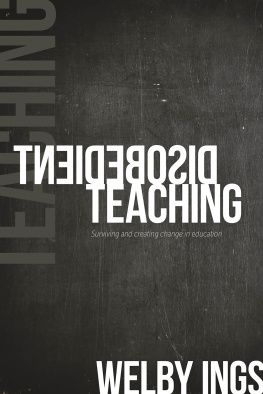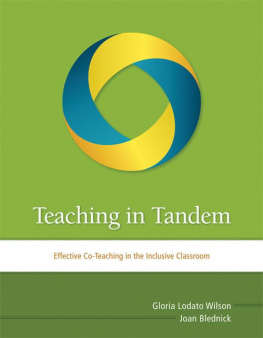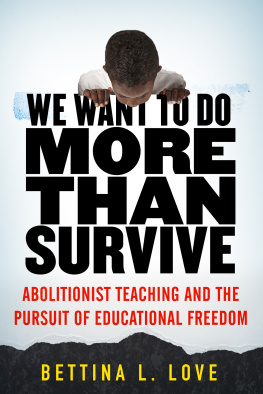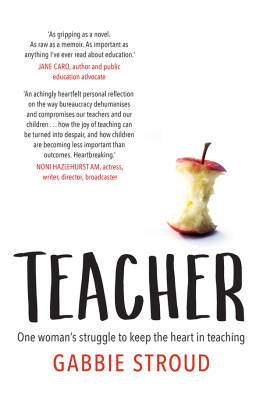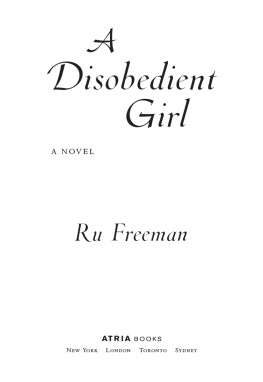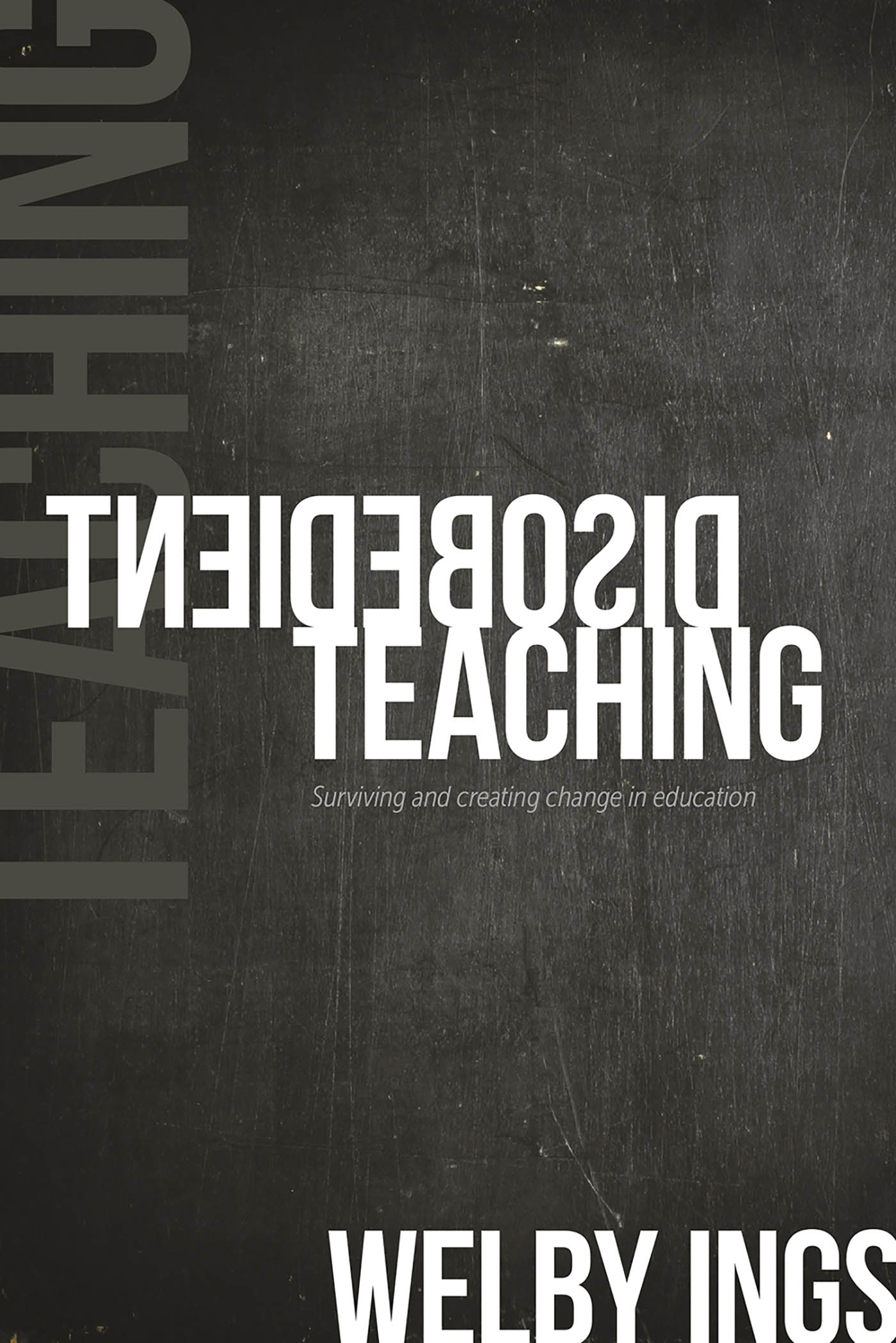ACKNOWLEDGEMENTS
How do you acknowledge a lifetime of learning? A book like Disobedient Teaching only happens because of the influence of teachers. So to those who knew that there was more to intelligence than passing level tests, I am indebted to you. I appreciated being left alone to draw pictures during sustained silent reading lessons, being allowed to stay in the bottom maths group to play with Cuisenaire rods in Form Two, and being delegated to running the nature table with unbridled freedom (except for the removal of the road-killed opossum and a floating goldfish that eventually turned from milky white to putrescent green). I am thankful for the times that I wasnt tested, for the afternoons I was allowed to do projects I was interested in, and for those instances where you showed that you cared about what I was trying to become.
These are my positive memories of early education.
I owe my mother and father a lifetime of wonder, because they refused to accept that I was stupid and they taught me to follow my imagination and to consider the impact of my actions on other people.
I am indebted to my friend Jasna Romic, who spent hours tracking down obscure references for me, correcting details and cautioning me against excess. I am also thankful to Robin Charles, Jenni Jenkins, Christine Cremen and James Wakelin for their valuable feedback on chapters in this book.
I have been inspired by Colin Gibbs, David Sinfield, Evelyn Jull, Suzanne Ings, Ron Rashbrook, Bill Packard, Desna Jury, Jim Peters, Avon Hansen, Bevan Mudie, Anne McGlashan and Brian Clarke. You are fine educators who have profoundly altered my thinking.
Unless they are mentioned above, in this book the names of teachers and students have been changed so that they are not identifiable. In organisations I have, in four instances, also changed the gender of the individual to further protect their privacy and reputation. With the exception of my youthful alma maters, Pukeatua Primary and Te Awamutu College, all other learning environments remain anonymous or have been constructed using a fictional name.
This said, it is not possible to make anonymous my greatest debt: to every student I have taught and who in turn has taught me. You may never know the impact you have on teachers. You bring humanity to ritualised curriculum, meaning to learning and the most wondrous potential to knowledge.
You are a precious thing.
Not all teachers forget you.
Example is not the main thing in influencing others.
It is the only thing.
ALBERT SCHWEITZER
PROLOGUE
a small anomaly
It is late at night. Outside you can hear the hum of commuters as they make their exodus from the city. Their tyres swish through a black skin of water still clinging to the street. I am sitting here unsure how to begin talking about productive disobedience and how it re-forms the world in which we live.
In my office the light is dim. On the walls there are small objects eclectic scavengings, the detritus of many journeys. These are gifts I have been given because students across 40 years of teaching have known of my penchant for the unusual and neglected. They are poignant things: an old felt heart stuffed with lavender, a Julia Kristeva voodoo doll, a broken bicycle lamp brought back from the ferocity of a Soviet winter, and flowers now drained of colour, grown delicate and brittle with age. Among these objects there are two photographs, and perhaps we might begin by talking about these.
The first shows a boy. He is 10 years old. It was taken in the 1960s. In this picture he sits at a regulation wooden school desk looking up at the camera. The pencil poised in his hand is not his own, nor is the book in which he is pretending to write. Behind him, artfully arranged on the wall, are some paintings of mushrooms, but these are not his either.
The boys father and mother were shearing contractors who worked the woolsheds of Ngaroma, Arohena, Puahue and Parawera places most people have never heard of. At the time the photo was taken he couldnt read or write. In fact he wouldnt be able to do these things until he was 14. He was destined to live out his years in school at the bottom of the class. When he left primary school he would receive a certificate for being the bin monitor. Four years later he would be expelled from college. Although he would eventually enter teacher training, he would be suspended halfway through the programme. After his probation year of teaching he would be refused certification and he would resign. Although he would return to teaching, in subsequent years he would receive letters of admonishment from Education Boards and boards of governors. All of these were related to his propensity to break rules. There would be pickets outside one of the schools in which he taught and the protesters would demand his removal.
He would spend a lot of time fighting.
The second photo is a page torn out of Time magazine. It is of a man in his fifties who has just received an award. Hes a professor. In the years that follow this photograph he would be given medals for his research and teaching and his PhD students would become thought leaders who changed organisations around the world.
His trajectory would be a blaze of acknowledgement. Although he would go to the same teachers training college as the boy in the other photograph, he would graduate with distinction. Across his years in primary, intermediate and secondary teaching, educators would be ferried through his classrooms to watch the innovative approaches he took to developing learning. He would become one of the architects of the New Zealand technology curriculum, he would found an alternative school, and in 2004 he would be awarded the countrys first PhD in creative practice. Today he is an advisor on creativity to a range of international business and educational organisations. The films he has created have screened at Cannes and Berlin and have been shortlisted for the Oscars. In 2001, in recognition of his contribution to education, he was awarded the inaugural New Zealand Prime Ministers Supreme Award for Teaching Excellence.

